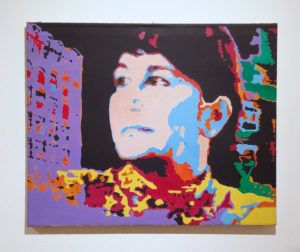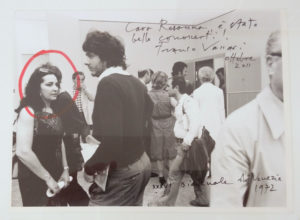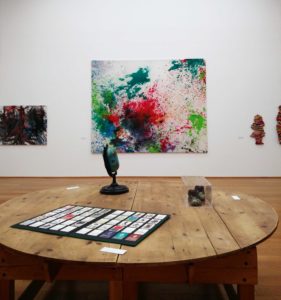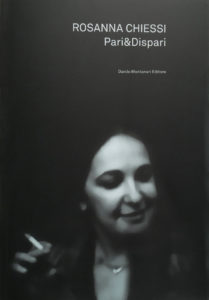 MAMbo – Project Room
MAMbo – Project Room
25 May – 16 September 2018
In May 2018 the MAMbo (Museo d’Arte Moderna, Bologna) opened the exhibition “Rosanna Chiessi. Pari&Dispari” in its Project Room. This Project Room is dedicated to point on artists and art actors with an anchoring in the region, but not only. The choice of Rosanna Chiessi is exemplary, because she supported over 50 years national artists and invited international artists to work with her. In doing so, her attention was directed to the artistic research and not to a production for the art market.
A life for art
Born in 1934, Rosanna Chiessi was attached to her home region, without being limited to it. At the end of the 1950s, arises her interest and passion for art and art history, probably due to the cultural renaissance in Reggio Emilia. In 1962, she opened with a friend her first art gallery: Il Portico. Until 1965 the gallery showed Italian artists from the second half of the 20th century. From 1968 she concentrated on Art Informel, Op art and visual poetry. From the beginning, she had a preference for movements rupturing with the conventions.
 To support “her” artists, Rosanna Chiessi founded in 1971 her publishing house “Pari&Dispari” (~ Equal & Different) in Reggio Emilia. Besides her publishing activities, she organised events, festivals and exhibitions. In addition, she participated in international art fairs, inter alia in Basel, Düsseldorf, Cologne and Bologna. Consequently, she expanded her contacts in direction to the Fluxus movement and Viennese Actionism. With these artists, she produced rare editions, exhibitions, performances and concerts. Her relationship to the artists was not limited to artistic exchange, but also private. Between 1976 and 1989 she accommodated the principal artists of the mentioned art movements and the Italian avant-garde at her house in Cavriago: inter alia Hermann Nitsch, Gerhard Rühm, Dick Higgins, Joe Jones, Alison Knowles, Nam June Paik, Charlotte Moorman, Ben Patterson, Arrigo Lora Totino, Jakob De Chirico and Luigi Mainolfi.
To support “her” artists, Rosanna Chiessi founded in 1971 her publishing house “Pari&Dispari” (~ Equal & Different) in Reggio Emilia. Besides her publishing activities, she organised events, festivals and exhibitions. In addition, she participated in international art fairs, inter alia in Basel, Düsseldorf, Cologne and Bologna. Consequently, she expanded her contacts in direction to the Fluxus movement and Viennese Actionism. With these artists, she produced rare editions, exhibitions, performances and concerts. Her relationship to the artists was not limited to artistic exchange, but also private. Between 1976 and 1989 she accommodated the principal artists of the mentioned art movements and the Italian avant-garde at her house in Cavriago: inter alia Hermann Nitsch, Gerhard Rühm, Dick Higgins, Joe Jones, Alison Knowles, Nam June Paik, Charlotte Moorman, Ben Patterson, Arrigo Lora Totino, Jakob De Chirico and Luigi Mainolfi.
During the 1990s, Rosanna Chiessi lived on Capri and continued her artistic activities there. In 1997, she returned to Reggio Emilia and founded a new gallery. Here she exposed Urs Lüthi, Ben Patterson and others. Not limited regionally, she opened a gallery in Berlin in 2000 and a year later another with Franco Marinotti. Back in her hometown in 2005, she created a centre for contemporary art together with Andrea Sassi. At the same time, she contacted and promoted the Japanese artistic movement GUTAI. Until her death in 2016, Rosanna Chiessi continued her activities in the Emilian region, Capri and several other illustrious places in Italy.
A biography around a table
 The current exhibition in Bologna follows a loose biographical approach. Introduced by the portrait “Sunset Rosanna” by Ann Tardos, there is a huge round table in the centre. It is coming from the house of Rosanna Chiessi in Cavriago, where she accommodated so many renowned artists during the years. Also in this time, the table was a crucial element: here the host and her guests exchanged, worked, ate, performed and celebrated. Shozo Shimamotos’ shoes, worn during a performance in 2011 witness of that. They communicate with the large painting “Certosa 11” by the same artist, created during an earlier performance at Capri.
The current exhibition in Bologna follows a loose biographical approach. Introduced by the portrait “Sunset Rosanna” by Ann Tardos, there is a huge round table in the centre. It is coming from the house of Rosanna Chiessi in Cavriago, where she accommodated so many renowned artists during the years. Also in this time, the table was a crucial element: here the host and her guests exchanged, worked, ate, performed and celebrated. Shozo Shimamotos’ shoes, worn during a performance in 2011 witness of that. They communicate with the large painting “Certosa 11” by the same artist, created during an earlier performance at Capri.
A certainly incisive encounter with Joseph Beuys in 1969 in Düsseldorf, is represented by a “Signed Jacket” of the artist. Here Rosanna Chiessa understood the significance of “Freedom of expression”. Four photos show a performance with violin in Reggio Emilia by Charlotte Moorman and Nam June Paik. Illustrated letters to Rosanna Chiessi by Dieter Roth witness of the personal relationship. A folder with playing cards created by various artists refer to the editorial activities of “Pari&Dispari”, as well as the double key by Giulio Bizzarri and Corrado Costa, logo of the publishing house.
In the exhibition, there are numerous unique pieces, editions, photos of performances or private situations. Moreover, there are several video’s documenting preparations for events, exhibitions, interviews, happenings and performances. Herewith, the “silent” witnesses of Rosann Chiessi’s activities are filled with life. Even though, the show seems to be limited to only one room, the visitor should bring time to discover all the different elements and plunge in the avant-garde undertakings.
You can take something home
 For the ones, who would like to know even more about Rosanna Chiessi, a catalogue to the exhibition is released. At present, it is the largest publication about her person and her activities.
For the ones, who would like to know even more about Rosanna Chiessi, a catalogue to the exhibition is released. At present, it is the largest publication about her person and her activities.
Self-evident, there are photos from the displayed items. As introduction, there are articles by Roberto Grandi (president of the Institution Bolognese Museums), Lorenzo Balbi (artistic director of the MAMbo and curator of the exhibition), Fabiola Naldi (art critic) and Giordano Gasparini (director of the cultural services of the municipality of Reggio Emilia and director of the Biblioteca Panizzi, where the archive of Pari&Dispari is). A biography, a list of cooperating artists and art events illustrates the huge network of Rosanna Chiessi. Nevertheless, a highlight are the retrospective texts and homage contributions of several artists. Furthermore, some of the texts are translated into English.
And you can come back
Two months before her dead, Rosanna Chiessi gave an interview. Result is the film “Rosanna Chiessi, L’ULTIMO INTERVISTA, dagli esordi a Shimamoto” (Rosanna Chiessi, THE LAST INTERVIEW, from the beginnings to Shimamoto, 30 min., with English subtitles), by Kerstin Petrick and Enrico Magnani. It was for the first time projected on the occasion of the exhibition’s opening in May. From June to August 2018 the film is on view in the conference room of the MAMbo on Thursday evenings. The entry is free.


















